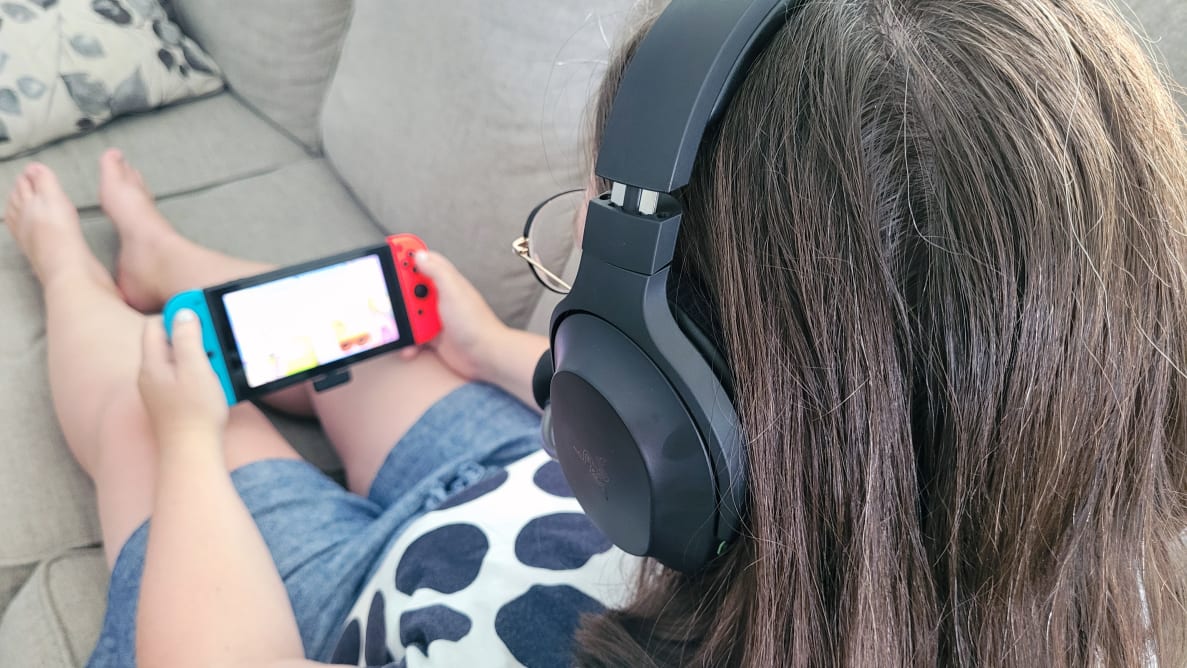Pros
-
Extremely flexible to use
-
All day comfort
-
Good sound
Cons
-
Microphone could be better
-
Bare-bones features
The Barracuda X provides a refreshingly simple, plug-and-play kind of experience across a wide variety of devices. While not the most comfortably padded headset you can buy, it’s surprisingly lightweight, making it a great choice for music or games on the go as well as at home.
The lack of features and customizability options here may frustrate gamers looking for a more sculpted experience. If you’re in that camp, you might want to browse other great gaming headsets. For everyone else, the Razer Barracuda X is a big win, especially for less than $100.
About the Razer Barracuda X
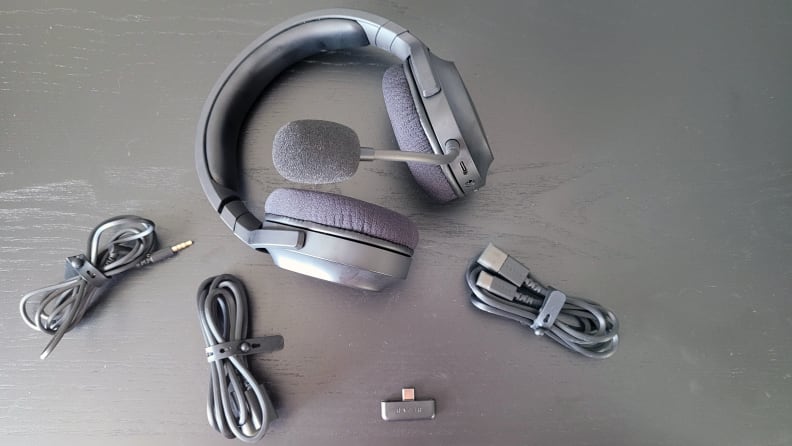
The included accessories are surprisingly high quality considering this headset's price.
Here are the Barracuda X’s notable specs at a glance:
- Cost: $99.99
- Style: Over-ear
- Colors: Black
- Drivers: 40mm
- Connections: Wireless (USB-C transceiver for PC, PlayStation 5, Nintendo Switch, Android devices), wired (Xbox, other devices)
- Battery life: ~24 hours
- Microphone: Detachable, cardioid, omnidirectional
- Weight: 250 grams
The Barracuda X is a surprisingly light, compact gaming headset that works wirelessly across a variety of ecosystems. The tiny USB-C transceiver that’s included can easily be plugged into an Android smartphone, laptop, or a Nintendo Switch, for example, giving this headset a real plug-and-play feel.
In the box, Razer includes a USB-C/USB-A extender to use with the USB-C transmitter for devices without USB-C ports. For everything else, like the Xbox, there’s a 3.5mm cable for passive, wired listening anywhere a 3.5mm input is available. You’re also getting a USB-C charging cable of good length—and there’s even a couple of Razer stickers in the box!
What we like
Refreshingly simple design

The Barracuda X is surprisingly light, and its detachable microphone makes it easy to wear when you're out and about.
From its Flowknit memory foam ear cups to the firm but lightweight black plastic around the headband, the Barracuda X is laudable for its comfort and wearability: At 250 grams, the Barracuda X weighs less than some of the most comfortable headphones I’ve used, like the Sony WH- 1000XM4. And while it isn’t as plush or comfortably padded as pricier headsets, its sleek build (and detachable microphone) make it a decent choice for using on-the-go.
Speaking of using it on the go: I enjoy the neon revelry of RGB products and Razer’s signature green tri-snake logo as much as the next gamer, but the level of restraint in branding and lack of loud design details here is worth mentioning.
The Razer logo is just barely visible on the back of each earcup, and the only other hint of Razer’s classic branding is a ring of green around the microphone’s dedicated mute button. In other words, you won’t be embarrassed to wear these in public. (I suppose if you’re disappointed by the lack of overt branding, you could always slap the included stickers onto the back of each cup.)
Plug-and-play all-day
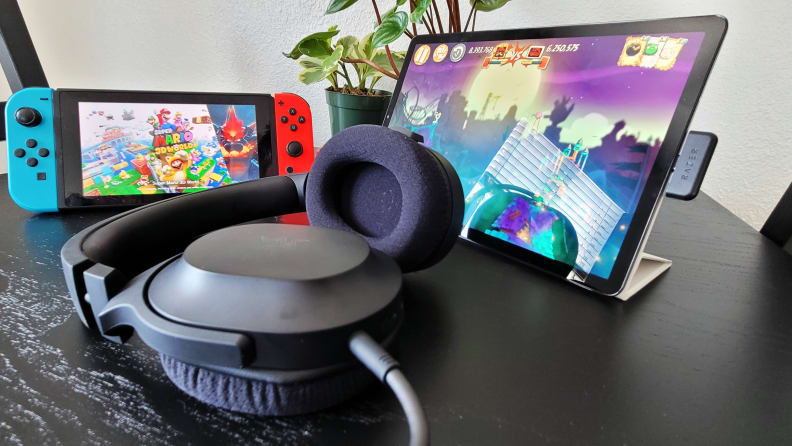
To use the Barracuda X with a product—like a Nintendo Switch or an Android tablet—simply plug its USB-C transceiver into a port.
Gaming headsets can be too complex on occasion, and introducing a new gaming headset into your desk or gaming space can sometimes feel like a chore. Often, you need to download companion apps, update or download drivers, set up RGB lighting, or change your console settings for input/output just to get started.
The Barracuda X’s plug-and-play approach is refreshingly simple by comparison. Just plug the included USB-C transceiver into your laptop, Nintendo Switch, smartphone, tablet, PS5, etc., power on the headset, and you’re good to go, sans wires. You can also use the Barracuda X in a wired capacity with any device that offers a 3.5mm input.
Likewise, there are no touch controls here, no additional software to download—just a line of buttons along the back of the left cup. While I wouldn’t call the Barracuda X’s control scheme intuitive, it’s easy enough to figure out after a couple hours of use.
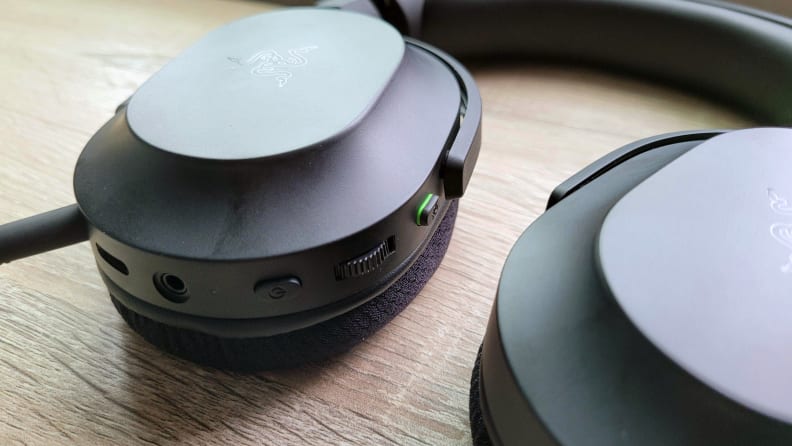
From top to bottom along the back of the left ear cup, you'll find the microphone mute button, volume wheel, power/function button, 3.5mm input, USB-C charging port, and microphone jack.
Starting below the headband arm and ending around the bottom of the left cup, there’s a line of buttons that include the microphone’s mute button, a volume wheel, the multi-function power button (click to play/pause music, answer calls, double-tap to skip song forward, triple-tap to skip song backward), a 3.5mm input, USB-C input, and the input for the detachable microphone.
I found that controlling everything was easy enough, especially because each button has a distinct enough tactile profile to ascertain by touch. Having separately adjustable volume controls between my PC and the headset itself felt a bit old-fashioned at first, and double/triple tapping the power button to skip tracks didn’t always work flawlessly. But that minor control issue aside, the Barracuda X’s simple design, controls, and plug-and-play experience are its strongest selling points.
Great battery life
The lack of features and frills here may not appeal to every gamer, but one big advantage to this simplicity is how long the battery lasts. Communicating solely with the USB-C transceiver over a 2.4 GHz wireless signal, the Barracuda X manages to last up to 24 hours between charges.
Compared to many pricier gaming headsets, that’s a handful of hours above the average, which is closer to 15-20—not bad for a “casual” $99 option. In keeping with this headset’s plug-and-play aesthetic, it means you won’t have to constantly worry about battery level. As a bonus, if it does run out of battery, you can just use it passively (via the 3.5mm cable) while it charges back up.
Decent enough sound

While it might not be ideal for hyper-competitive gaming situations, the Razer Barracuda X sounds solid where most types of gaming and music are concerned.
With this headset, your $100 is getting you easy wireless usability, a sleek/lightweight design, and good battery life—and that’s primarily what you’re paying for. The sound quality is fine but isn’t going to blow anyone away. It isn’t bad, but it’s probably the least remarkable aspect of the Barracuda X.
Like with most of the gaming headsets I test, the first thing I did was listen to music—without the paired visual aspect of gameplay, it can be much easier to assess a headphone’s frequency response by ear. And while the Barracuda X handles the majority of the midrange and some bass frequencies handily, it’s lacking in both deep, rumbling sub-bass tones and higher, sparkling trebles.
In adhering to its casual, multi-platform viability, I also used this headset while playing a fairly eclectic mix of games: Magic Arena on my Windows PC, Angry Birds 2 on my Android tablet, Skyrim (via Xbox Game Pass) on my smartphone and Super Mario 3D World on Nintendo Switch, all wirelessly via the USB-C transceiver. I also plugged the headset directly into my Xbox Series X controller for some co-op gaming and chatting in The Ascent.
As suspected, for less competitive and less symphonic games, the Barracuda X is great. Necessary sounds are well-preserved, and the audio quality is consistent across device architectures. Game audio stings and cues were clearly audible, and music sounded fine if a bit flat at times. As an added bonus, I’ve noticed that whether I’m listening wirelessly or wired, the audio quality is roughly the same.
However, I call it “decent enough” sound because it simply can’t stand up to higher-end headsets: even the Corsair HS80 that I recently reviewed, which costs $50 more, sounds better in terms of audio dynamism. The Barracuda X’s closest sound twin might be the Xbox Wireless Headset, which costs the same—the difference being that you can tweak the latter’s EQ from your Xbox console.
The Barracuda X gets the job done for most types of games, but it isn’t a great choice for more competitive options where spatial tracking, customization, and hyper-awareness might be key to victory.
What we don’t like
This microphone is a bit weak, dude

Whether you're using it wirelessly or wired, the Barracuda X sounds pretty good, though it lacks a bit by way of sub-bass and high treble frequencies.
Any time I’m testing a gaming headset, I tend to use the microphone in two controlled settings: gaming with two old high school pals, and during my weekly D&D games over Skype. I invariably get feedback this way: Usually, I’m told I sound clearer or louder, but sometimes I’m informed that a headset’s microphone is weaksauce.
In the case of the Barracuda X, the detachable omnidirectional cardioid microphone isn’t awful, but it may be the weakest link in the headset chain. I was audible all throughout sessions of The Ascent and Dungeons & Dragons (via Skype), but didn’t always feel entirely confident that I’d be heard clearly without raising my voice a bit beyond its normal volume. To check, I compared the microphone quality with my Logitech C920 webcam microphone. The Barracuda X wasn’t oodles worse, but most headsets outpace a webcam mic.
I think for casual gaming, this microphone is perfectly fine, but I don’t know that I would want to use it during a work presentation, an important phone call, or an intense team-based multiplayer game where communication is vital. The occasional muffle or muddy moment may only bother very picky players, but it’s worth knowing about before you buy.
A crowded cutting-room floor
The Barracuda X’s simplicity in design and user experience is one of my favorite things about it—but I could also see the overt lack of features becoming annoying to experienced gamers. The Barracuda X doesn’t interface at all with Razer’s Synapse software, for example, meaning there’s no way to adjust its EQ, game/chat volume, or even to install any firmware updates.
In fact, there isn’t even a way to check the exact battery level. A single LED indicator informs you when the headset is searching for the USB-C transceiver and when it’s connected; this same indicator doubles as a battery indicator, changing from blue to red as it runs out. It’ll blink red when there’s 10% or less battery left.
The Barracuda X is perfectly usable without these extras, but interested buyers should be aware of how bare-bones the experience can be, especially if you’re used to kitted-out gaming headsets.
Poor isolation

Razer's Flowknit ear cups are plenty comfy, but they don't block out sound very well. I can still hear all of my cat's meows.
This one might be a nitpick, but if you plan to use the Barracuda X as on-the-go headphones, you should be aware that its Flowknit cups and gentle clamp don’t do much by way of sealing out outside sound—you could say they flow a little too much.
For example, while using the Barracuda X to listen to music, I could still easily hear my cat’s plaintive meows and occasional sounds outside my window, especially during quieter bars.
This also means that whatever you’re listening to—music, podcasts, games—is going to be at least somewhat audible to folks around you, depending upon how loud it is. While you might not mind the sounds of Fortnite interrupting your neighbor’s sleep during a flight, they just might, am I right?
One little design flaw

The included USB-C transceiver is positively tiny, though it may still block some of your ports. Quarter for scale.
One more little nitpick: the USB-C transceiver is so tiny, it could be easy to lose, especially if you’re regularly throwing the Barracuda X into a bag to take on the go. And if you lose it, that’s it for wireless use. It doesn’t have Bluetooth, so suddenly you’ve got a $99 wired headset. In 2021? No thank you.
It would be great if there was some kind of on-headset method for storing the transceiver. You can always plug it into the headset’s own USB-C charging port, or more simply, you could just keep it in your phone’s USB-C input.
Ironically, despite how tiny the transceiver is, it also can block ports. It’ll be fine in your PS5 or Android tablet, but may block some headphone inputs on phones (it blocks the headphone input on my laptop, for example). Users may also have an issue if they use a particularly thick or heavy phone case.
Should you buy it?
Yes, if you want something straightforward and flexible
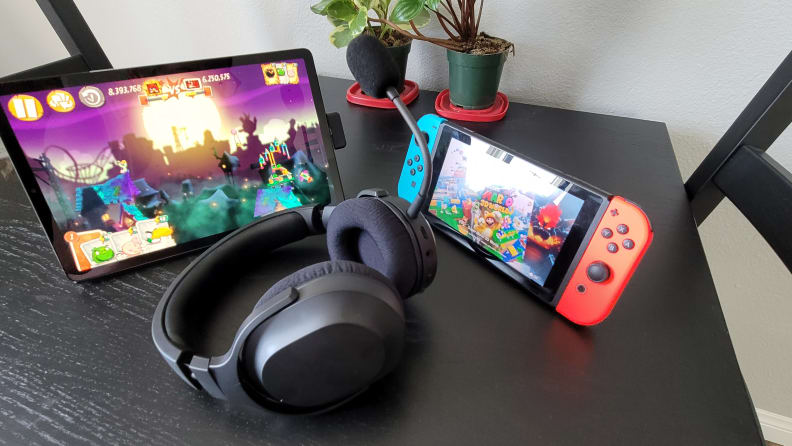
For less than $100, this headset's value is anything but casual.
There’s something delightful about how easy the Razer Barracuda X is to use. My laptop, smartphone, and tablet—all my major gaming devices besides my Xbox—are outfitted with USB-C inputs, making it easy to pop the transceiver into whichever device and instantly connect—and it’s as fast or faster than Bluetooth in this case. The dedicated volume wheel, long battery life, and detachable microphone all make gaming at home, listening on the go, and anything in between exceedingly easy to do. This isn’t as simple as a pair of true wireless earbuds, but it’s about as close as gaming headsets get.
The only caveat has to do with if the fancier features on more expensive gaming headsets are must-haves for you. The audio quality here is just alright, the microphone is only so-so, and the complete lack of features may feel like a downgrade if you’re used to better-sounding or more kitted-out gaming headsets. If that's the case, I'd recommend checking out the Audeze Penrose, which has awesome audio quality. And if you want more of an emphasis on gaming-facing features, check out the SteelSeries Arctis Pro.
When I was 24 and playing competitive shooters like they were paying me to play ‘em, I don’t think I would have wanted this headset. But nowadays—with less free time, and gaming so widely available as a mobile, bite-sized activity—a simple, comfortable headset like this is just the ticket. And thanks to its multi-platform flexibility, it will likely work with all your gaming devices. For $99, this value is anything but casual.
Meet the tester
Lee was Reviewed's point person for most television and home theater products from 2012 until early 2022. Lee received Level II certification in TV calibration from the Imaging Science Foundation in 2013. As Editor of the Home Theater vertical, Lee oversaw reviews of TVs, monitors, soundbars, and Bluetooth speakers. He also reviewed headphones, and has a background in music performance.
Checking our work.
Our team is here to help you buy the best stuff and love what you own. Our writers, editors, and experts obsess over the products we cover to make sure you're confident and satisfied. Have a different opinion about something we recommend? Email us and we'll compare notes.
Shoot us an email
